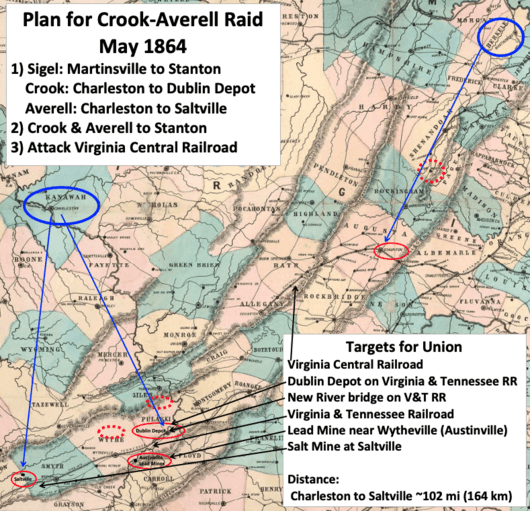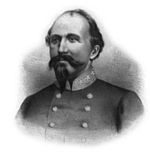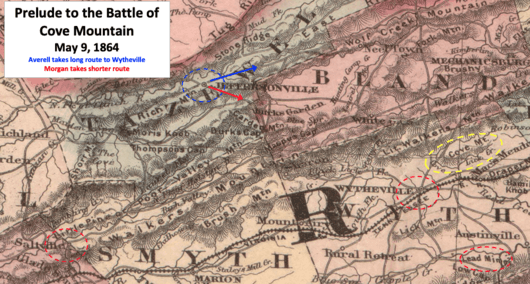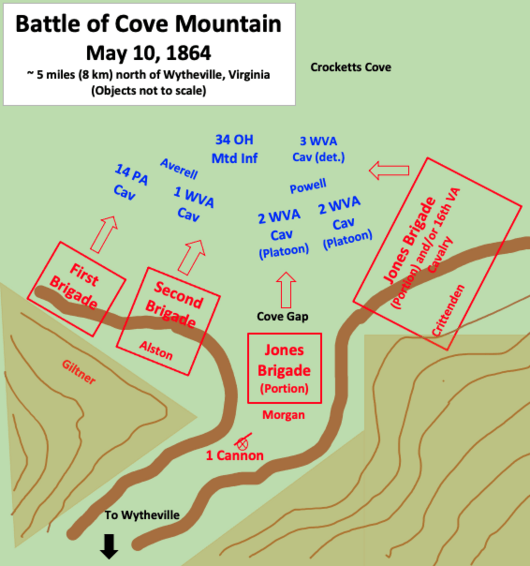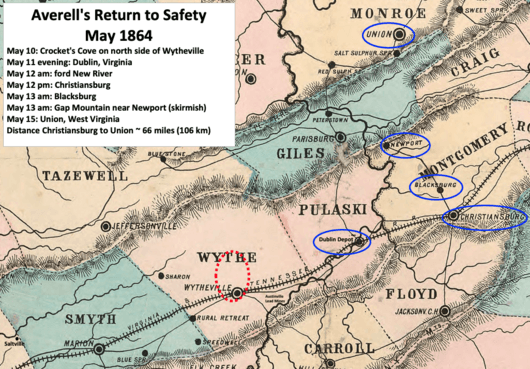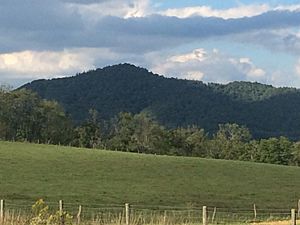Battle of Cove Mountain facts for kids
Quick facts for kids Battle of Cove Mountain |
|||||||
|---|---|---|---|---|---|---|---|
| Part of American Civil War | |||||||
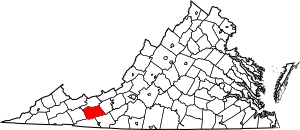 Wythe County in Virginia |
|||||||
|
|||||||
| Belligerents | |||||||
| Commanders and leaders | |||||||
| Units involved | |||||||
|
|
||||||
| Strength | |||||||
| 2,019 | 4,000 | ||||||
| Casualties and losses | |||||||
| 114 | 50 | ||||||
The Battle of Cove Mountain took place in Wythe County, Virginia, on May 10, 1864. It was a part of the American Civil War. During this battle, a smaller Union cavalry group, led by Brigadier General William W. Averell, tried to attack an important lead mine. The mine was located near Wytheville. However, Confederate forces, commanded by Brigadier General John Hunt Morgan, stopped Averell. They met at Cove Gap, which is next to Crockett's Cove and Cove Mountain.
Averell's group and a larger force led by Brigadier General George Crook were part of a Union plan. Their goal was to damage the Virginia and Tennessee Railroad. This railroad was vital for the Confederacy. It moved soldiers and supplies, and served important lead and salt mines. Averell was supposed to attack these mines. But he was stopped at Cove Gap while trying to reach the lead mine. After escaping through the mountains at night, Averell's cavalry was chased for five days. Finally, Averell's group met up with Crook's force in Union, West Virginia.
The National Park Service says this battle had an "indecisive" result. Confederate reports, however, called it a victory for Morgan. Confederate troops successfully kept Averell from destroying the salt and lead mines. These mines were very important for the Confederacy to preserve food and make bullets. But because the Confederates were worried about Averell, many of their troops could not help at the Battle of Cloyd's Mountain. At Cloyd's Mountain, Crook's 6,000 men won a big victory. Crook was able to destroy a large railroad bridge and other key railroad structures.
Contents
Why Was This Battle Fought?
In March 1864, Lieutenant General Ulysses S. Grant became the leader of all Union armed forces. Grant's plan for Virginia was to attack the strongest Confederate Army. This was Robert E. Lee's Army of Northern Virginia. Grant wanted to attack from many different directions.
Important targets included the Virginia and Tennessee Railroad and the Virginia Central Railroad. These railroads carried food from the Shenandoah Valley to feed Lee's army. They also moved troops between battle areas. The Virginia and Tennessee Railroad connected the Confederate capital of Richmond with Tennessee. It was used to move minerals like salt and lead to factories. These factories were in places like Lynchburg, Petersburg, and Richmond.
Brigadier General George Crook was given the job of attacking the Virginia and Tennessee Railroad. His force had about 6,155 men. Brigadier General William W. Averell led a smaller group. Averell's mission was to attack a salt mine in Saltville, Virginia. This mine produced about two-thirds of the Confederacy's salt. Salt was crucial for preserving meat.
Further east on the railroad was a lead mine near Wytheville, Virginia. This mine provided most of the lead for Confederate bullets. Even further east was a Confederate Army headquarters at the Dublin Depot. Near there was a big railroad bridge over the New River. This bridge was one of Crook's main targets.
Who Fought in the Battle?
Union Forces
General Averell left his camp in early May with two brigades. A brigade is a large group of soldiers. He had 2,019 officers and men. His main commanders were Brigadier General Alfred N. Duffié and Colonel James M. Schoonmaker.
Schoonmaker's brigade had the 1st West Virginia Cavalry Regiment and the 14th Pennsylvania Cavalry Regiment. Many of these soldiers had special seven-shot Spencer repeating rifles. Other Union cavalry soldiers usually carried revolvers, sabers, and single-shot carbines.
Confederate Forces
The Confederate Army knew Union forces were moving. So, they sent Brigadier General John Hunt Morgan and his two brigades to Saltville. Morgan's First Brigade was led by Colonel Henry Giltner. His Second Brigade was led by Lieutenant Colonel Robert A. Alston.
Morgan sent about 400 of his men, who didn't have horses, to the Dublin Depot. They went to help fight General Crook. Morgan then focused his remaining forces on Averell. Most of Morgan's men were from Kentucky or Tennessee. However, Giltner's brigade knew the area well from serving there before.
Other Confederate troops also fought at Cove Mountain. A group called Jones' Brigade arrived before Morgan. This brigade was led by Colonel George B. Crittenden. The 16th Virginia Cavalry Regiment also came to help Morgan.
The March to Wytheville
Averell's men started their journey on May 5, 1864. They moved south, crossing into Virginia on May 7. Along the way, they had small fights with enemy scouts. They even captured some Confederate soldiers.
Averell learned from captured soldiers that the Confederates knew his plan. He found out that 4,500 Confederate troops, led by Morgan and William "Grumble" Jones, were waiting for him at Saltville. With this information, Averell changed his plan. He decided to attack the railroad further east at Wytheville instead. He hoped this would keep Morgan and Jones busy so they couldn't stop Crook.
Averell took a difficult, longer route through the mountains. Morgan, however, knew the area better. He took a direct, shorter route to Wytheville. Morgan arrived in Wytheville before his main force. He immediately ordered Confederate troops there to guard the mountain gap. This was the gap Averell needed to pass through to reach Wytheville. The people of Wytheville were very happy to see Morgan. They remembered when their town was destroyed in 1863.
The Battle Begins
To reach Wytheville and the lead mine, Averell's troops had to go through a small mountain gap. But when they arrived, Confederate soldiers already occupied it. More of Morgan's men were also moving into position. Morgan's force was said to be about 4,000 men.
The battle started when Schoonmaker's Union cavalry pushed back the Confederate guards. But as the Union cavalry got too close, dismounted Confederate soldiers on both sides of the gap forced them back. A Union soldier climbed a tree and saw that the Confederates were getting many more soldiers. This information stopped a planned Union charge. The Union soldiers didn't know it, but the Confederates had hidden a cannon in the road.
Morgan's Attack
Morgan's main force reached Wytheville around 3:00 PM and then headed to the gap. Colonel Giltner's brigade and Lieutenant Colonel Alston's brigade tried to circle around Averell's right side. Averell's men fell back to try and draw the Confederates out into the open.
A large Confederate force came out of the gap, and heavy fighting began. Giltner's two brigades attacked Averell's right side. Morgan personally led Jones' Brigade against Averell's left center. They used the cannon from Wytheville. A third Confederate force attacked Averell's far left. A Union soldier remembered the Confederate battle cry: "We are Morgan's men and will give you hell!"
Early in the fight, a bullet grazed Averell's forehead. It was a small wound but bled a lot. He had to temporarily give up command. Colonel Powell took over. Powell's men moved back slowly and in an organized way, even under heavy fire. Averell later said they saved the left side of his division. The fighting lasted about four hours and ended at dusk.
Battle Losses
Averell reported that his side lost 114 officers and men. Most estimates say Confederate losses were between 40 and 60 men. One Union soldier thought the Confederates had more losses because they did most of the attacking. Another Union soldier believed that if the fighting had continued, half of their force would have been captured. Morgan thought he could have captured all of Averell's men if he had two more hours of daylight.
Escape Through the Mountains
Averell used a clever trick to save his troops. He told an officer, loudly enough for a local woman to hear, that General Crook's forces would arrive soon. He hoped this false information would reach the Confederates. Then, he had an officer pretend to announce Crook's arrival. Finally, he ordered his men to cheer loudly for General Crook.
It's not clear if the trick or the darkness stopped the fighting, but Morgan's men went back to the gap. Averell then had his men build many fires, about one for every two men. This made it look like Crook's large army had arrived.
Under the cover of darkness, Averell's force quietly left. The badly wounded soldiers were left at the Crockett's Cove Presbyterian Church. Averell's men had to climb and descend a mountain with no good road. They walked, leading their horses. By dawn, they were at the bottom of the mountain, far from the cove. They rested before continuing to the Dublin Rail Depot.
On the evening of May 11, the Union soldiers reached the depot. They spent the night there in heavy rain. They found that Crook had already destroyed the big railroad bridge over the New River. The river was also rising quickly because of the rain. Averell's men crossed the New River about 3 miles (4.8 km) west of Christiansburg. Several men and horses drowned in the strong current.
Journey Home
From Christiansburg, Averell contacted Crook. He was ordered to destroy more railroad tracks. They destroyed the depot and four miles (6.4 km) of track. Then, they started their trip back to the safety of West Virginia. Much of their ammunition was ruined by the river and rain. Averell later said his "ammunition was nearly exhausted." He also learned through a trick on a telegraph that Confederate troops were coming. So, he decided it was best to join Crook's group and head north.
Confederate forces chased Averell. But they couldn't catch him at Blacksburg. The chase continued north. On May 13, rain made the mountain paths slippery and streams dangerous. Averell's men had to cross a steep mountain on foot, leading their horses. They continued north on "narrow and unfrequented paths and roads." On May 15, Averell finally met Crook near Union, West Virginia.
What Happened After the Battle?
The National Park Service calls the Battle of Cove Mountain "indecisive." Averell praised his troops. He said they "attacked and held a superior force of the enemy... thereby enabling another column to accomplish its purpose." The New York Times called Averell's raid "one of the most hazardous and brilliant of the war." But a Confederate newspaper in Richmond called it "a very important victory."
Many leaders in the battle saw changes later that year. Duffié and Averell did not get along. Duffié moved to another division. He was later captured. Colonel Powell became a brigade commander and then replaced Averell as division commander. Both Powell and Schoonmaker later received the Medal of Honor for their bravery in other battles. On the Confederate side, Jones was killed in June. Morgan was killed in September.
Grant's plan to pressure Lee's army was only partly successful at first. Crook won a major victory at the Battle of Cloyd's Mountain. He destroyed the important New River bridge. However, Averell could not damage the salt or lead mines.
Later in 1864, Union Major General Philip Sheridan led many victories in the Shenandoah Valley. He destroyed much of the farms that fed Lee's army. Crook, Averell, Powell, and Schoonmaker all played important roles in Sheridan's army. In December 1864, Major General George Stoneman led a raid that badly damaged the Virginia and Tennessee Railroad. The Wythe County lead mines were damaged on December 17. The Saltville saltworks were severely damaged on December 20.
Preserving the Battlefield
As of 2001, the Cove Mountain battlefield at Crockett's Cove was still mostly unchanged. It had two historic houses, a cemetery, and the Crockett's Cove Presbyterian Church. The church is listed on the National Register of Historic Places. Seventeen Union soldiers died there. A Virginia historical marker is near the mountain gap. Another marker is at the church. The John Crockett House and Cemetery are in the middle of the cove.


